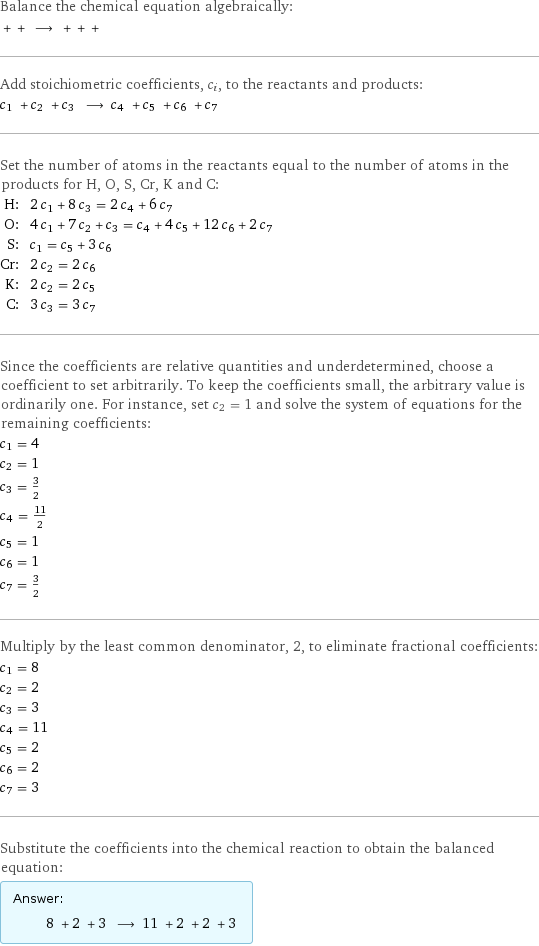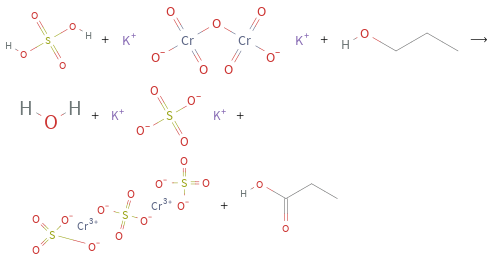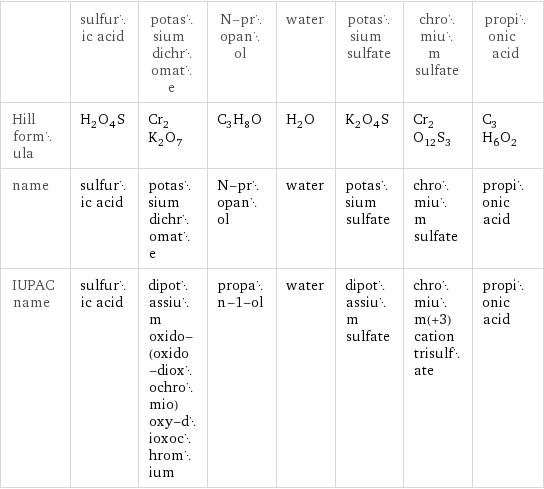Input interpretation

sulfuric acid + potassium dichromate + N-propanol ⟶ water + potassium sulfate + chromium sulfate + propionic acid
Balanced equation

Balance the chemical equation algebraically: + + ⟶ + + + Add stoichiometric coefficients, c_i, to the reactants and products: c_1 + c_2 + c_3 ⟶ c_4 + c_5 + c_6 + c_7 Set the number of atoms in the reactants equal to the number of atoms in the products for H, O, S, Cr, K and C: H: | 2 c_1 + 8 c_3 = 2 c_4 + 6 c_7 O: | 4 c_1 + 7 c_2 + c_3 = c_4 + 4 c_5 + 12 c_6 + 2 c_7 S: | c_1 = c_5 + 3 c_6 Cr: | 2 c_2 = 2 c_6 K: | 2 c_2 = 2 c_5 C: | 3 c_3 = 3 c_7 Since the coefficients are relative quantities and underdetermined, choose a coefficient to set arbitrarily. To keep the coefficients small, the arbitrary value is ordinarily one. For instance, set c_2 = 1 and solve the system of equations for the remaining coefficients: c_1 = 4 c_2 = 1 c_3 = 3/2 c_4 = 11/2 c_5 = 1 c_6 = 1 c_7 = 3/2 Multiply by the least common denominator, 2, to eliminate fractional coefficients: c_1 = 8 c_2 = 2 c_3 = 3 c_4 = 11 c_5 = 2 c_6 = 2 c_7 = 3 Substitute the coefficients into the chemical reaction to obtain the balanced equation: Answer: | | 8 + 2 + 3 ⟶ 11 + 2 + 2 + 3
Structures

+ + ⟶ + + +
Names

sulfuric acid + potassium dichromate + N-propanol ⟶ water + potassium sulfate + chromium sulfate + propionic acid
Equilibrium constant
![K_c = ([H2O]^11 [K2SO4]^2 [Cr2(SO4)3]^2 [CH3CH2COOH]^3)/([H2SO4]^8 [K2Cr2O7]^2 [CH3CH2CH2OH]^3)](../image_source/60384054e045d5a0f2ebc19825806fd4.png)
K_c = ([H2O]^11 [K2SO4]^2 [Cr2(SO4)3]^2 [CH3CH2COOH]^3)/([H2SO4]^8 [K2Cr2O7]^2 [CH3CH2CH2OH]^3)
Rate of reaction
![rate = -1/8 (Δ[H2SO4])/(Δt) = -1/2 (Δ[K2Cr2O7])/(Δt) = -1/3 (Δ[CH3CH2CH2OH])/(Δt) = 1/11 (Δ[H2O])/(Δt) = 1/2 (Δ[K2SO4])/(Δt) = 1/2 (Δ[Cr2(SO4)3])/(Δt) = 1/3 (Δ[CH3CH2COOH])/(Δt) (assuming constant volume and no accumulation of intermediates or side products)](../image_source/de6da28f9555095ba3b43efd39fd2cae.png)
rate = -1/8 (Δ[H2SO4])/(Δt) = -1/2 (Δ[K2Cr2O7])/(Δt) = -1/3 (Δ[CH3CH2CH2OH])/(Δt) = 1/11 (Δ[H2O])/(Δt) = 1/2 (Δ[K2SO4])/(Δt) = 1/2 (Δ[Cr2(SO4)3])/(Δt) = 1/3 (Δ[CH3CH2COOH])/(Δt) (assuming constant volume and no accumulation of intermediates or side products)
Chemical names and formulas

| sulfuric acid | potassium dichromate | N-propanol | water | potassium sulfate | chromium sulfate | propionic acid Hill formula | H_2O_4S | Cr_2K_2O_7 | C_3H_8O | H_2O | K_2O_4S | Cr_2O_12S_3 | C_3H_6O_2 name | sulfuric acid | potassium dichromate | N-propanol | water | potassium sulfate | chromium sulfate | propionic acid IUPAC name | sulfuric acid | dipotassium oxido-(oxido-dioxochromio)oxy-dioxochromium | propan-1-ol | water | dipotassium sulfate | chromium(+3) cation trisulfate | propionic acid